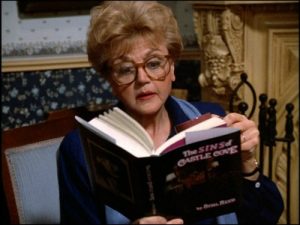As we mentioned here previously, we here at the Library are Resolving to Read (more…different….) in 2018, and tackling both Book Riot’s and Scholastic’s 2018 Reading Challenges. In the hopes of encouraging you to broader your literary horizons along with us, here are some suggestions for books that fall within the categories of the various challenges.
…And, like many of you, we’ve fallen a bit behind on our resolutions, dear readers! But everyday is a chance to try again all over again, so let’s get back on track, shall we? This week, we’re looking at the Scholastic 100 New Year’s Reading Resolutions. We love this list because it can be used by readers from any age to find new, exciting, and challenging books (and reading scenarios) to expand your literary horizons in 2018.
Today’s Challenge: Scholastic 100 New Year’s Reading Resolutions
Category: Read a Book Written by Someone Who’s From My State

Since the Peabody Library–and George Peabody himself, was from Massachusetts, we’re going to stick with this state as our category, but readers from other states, please check with your local library (or, heck, check with us!) to find some books from authors nearer to you.
Massachusetts has a rich literary legacy, beloved patrons, from Phillis Wheatley, who was the first published African-American female poet to London Bridgez, a spoken word poet, writer, and playwright who was a short list finalist for the 2016 Leslie Scalapino Award for Innovative Women Playwrights. From Anne Bradstreet, who was the first writer in England’s North American colonies to be published, to my own beloved Louisa May Alcott and her father Bronson..

In short, this is a category that can take you in any number of directions, and offers the potential for exploring a wealth of new books, types of story, and forms of story-telling. We offer just a few suggestions below for some books to help fulfill this part of your reading resolution–come speak to a member of our staff to find even more!
(Presented in alphabetical order)
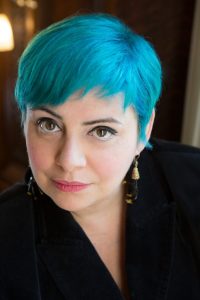
Holly Black: Although born in New Jersey, we are pleased as punch that she now lives in Massachusetts, and we can add her to this list. Black’s imagination and story-telling skills are powerful, indeed, and she has put them to use in novels, graphic novels, and short stories over the course of her impressive career. Black is perhaps most well-known for The Spiderwick Chronicles, the series she worked on in collaboration with her long-time friend, Caldecott award winning artist, Tony DiTerlizzi, which begins with the title The Field Guide. However, she is also a wonderful teller of fantasy and modern fairy tales. One of her most recent is The Coldest Girl in Coldtown, and features Tana, who lives in a world where walled cities called Coldtowns exist. In them, quarantined monsters and humans mingle in a decadently bloody mix of predator and prey. For those who enjoy reading about the fair folk, check out The Darkest Part of the Forest, which is set in a world where fairies and mortal live side-by-side. Hazel and Ben have been telling each other stories about the boy in the glass coffin, that he is a prince and they are valiant knights, pretending their prince would be different, kinder, from the other faeries. But as Hazel grows up, she puts aside those stories. Hazel knows the horned boy will never wake…until he does.

Dennis Lehane: Dorchester native Dennis Lehane’s work has put a new kind of Boston on the literary map. Instead of the stuffy, upper-case, subdued landscape of Henry James, Lehane’s characters tend to be poor; they tend to live in the working-class areas of the city that residents know well, but the outside world may have never visited. They deal in emotional extremes that make Lehane’s works compelling, gripping, scary, and stunningly moving. He’s also a gifted screen-writer who has produced shows for The Wire, and has written the script for The Drop and the adaptation of Stephen King’s Mr. Mercedes. Readers looking to get started in Lehane’s sometimes-seedy, but incredibly well-drawn and insightful world should immediately check out his Kensie and Gennaro series, featuring private detectives Patrick Kensie and Angie Gennaro. This series starts with A Drink Before the War, and winds through Boston’s streets, its suburbs, its drug and alcohol problems, its organized crime, and the wonderful, flawed, colorful people who make up its inhabitants. It’s also an incredible tale of a partnership that is unforgettable in its poignancy and honesty. Also, if your in the mood to have your pants scared off of you, check out Shutter Island, set in a mythical institution on an island off Boston Harbor. It’s so much better than the movie (even though the movie’s pretty great).

Kelly Link: A nominee for the 2016 Pulitzer Prize, Kelly Link is a formidable talent whose short stories are disquieting, disruptive, beautifully imagined and wonderfully written treasures. Stories from her first collection, Stranger Things Happen, were awarded the Nebula, the James Tiptree Jr., and the World Fantasy Awards–and the cover is a weird take on a Nancy Drew cover, which is just plain wonderful. There are elements of Shirley Jackson in Link’s slow-burning, captivating narration, while her story ideas have a lot to offer fans of Angela Carter’s work. Despite the weird and the magical in her tales, Link is also a master of human emotion, grounding these tales in honest, empathetic relationships–and making the inevitable twists and turns in the stories that much more surprising and shocking. Whether it’s “Origin Story”, from the book Get in Trouble, which deals with a woman and her erstwhile lover (who just happens to be a superhero), or “Stone Animals”, from Magic for Beginners, in which a house is haunted by a unique horde of rabbits that camp out nightly on the front lawn, it’s a pretty fair bet that you haven’t read anything like Kelly Link’s work before, but you’ll be very grateful you did.

Paul Tremblay: Paul Tremblay is a fan of libraries, which we can deduce by his appearances at the Merrimack Valley Halloween Book Festival at the Haverhill Library. He is not a fan of pickles, because he says so. But regardless of his choice of sides and snacks, Tremblay is one heck of a good writer. Like Stephen King, Tremblay can take the most innocuous things–a painted staircase, a blog, a notebook, a bag of fertilizer–and make those things the pulse-points of a genuinely unsettling, unforgettable story. His short stories are delightfully twisty, compact gems, and his novels are some of this Library’s favorites. Favorite among those favorites is A Head Full of Ghosts, which deals with the story of a teenage girl’s alleged possession, exorcism, and the reality tv show made about the events (which is set in Beverly, making is extra-awesome). Told in flashbacks, blog posts and interviews, this is a story full of dread, lies, and carries a killer twist. Mystery fans should also check out Tremblay’s PI series, which features Mark Genevich, a detective in South Boston who suffers from narcolepsy, which starts with the novel The Little Sleep. His newest book, The Cabin at the End of the World, is due out in a few short weeks!



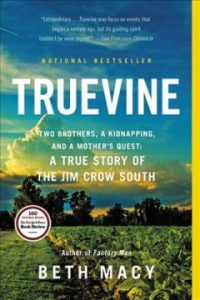
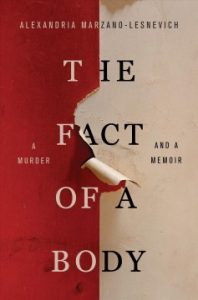
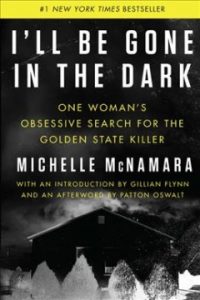
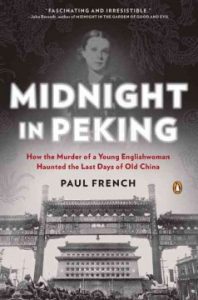
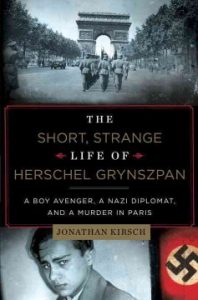

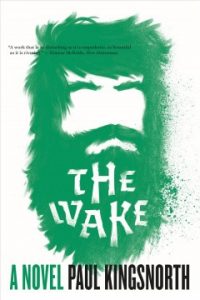
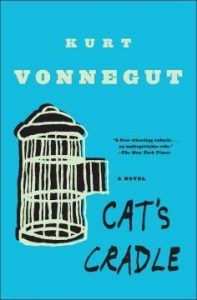

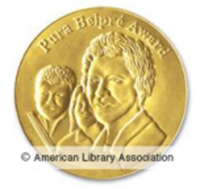
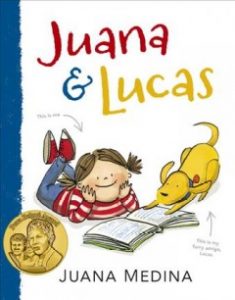
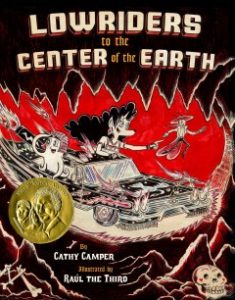
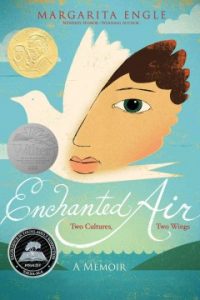
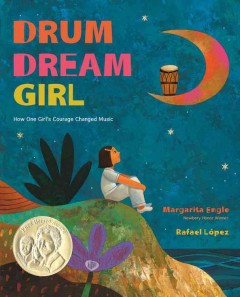
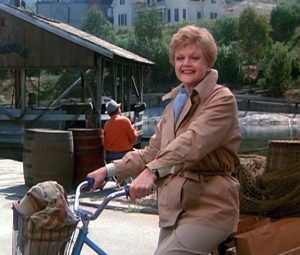
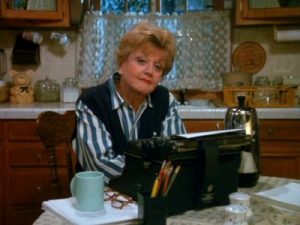 The format of these shows are pretty reliable in terms of plot–Jessica in involved in some endeavor that is broadening her horizons, whether that is traveling, preparing for visitors, finishing a new novel, working on her garden, or teaching a class (I remember that she taught writing and criminology, though I am sure there were more). In pretty short order, someone turns up dead under mysterious circumstances, and Jessica proves herself the only person capable of unmasking the murderer (if it were real, Cabot Cove would have one of the highest murder rates in the nation–higher than a city 20 times its size!). Usually, she is assisted or threatened in some way by a famous or soon-to-be famous guest star (
The format of these shows are pretty reliable in terms of plot–Jessica in involved in some endeavor that is broadening her horizons, whether that is traveling, preparing for visitors, finishing a new novel, working on her garden, or teaching a class (I remember that she taught writing and criminology, though I am sure there were more). In pretty short order, someone turns up dead under mysterious circumstances, and Jessica proves herself the only person capable of unmasking the murderer (if it were real, Cabot Cove would have one of the highest murder rates in the nation–higher than a city 20 times its size!). Usually, she is assisted or threatened in some way by a famous or soon-to-be famous guest star (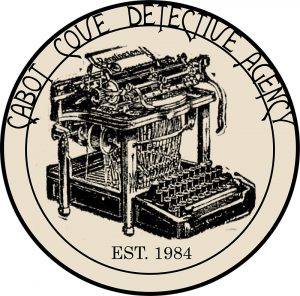 I am not alone in this quest. There have been several internet posts dedicated to
I am not alone in this quest. There have been several internet posts dedicated to 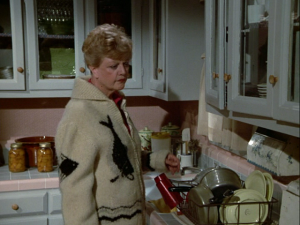
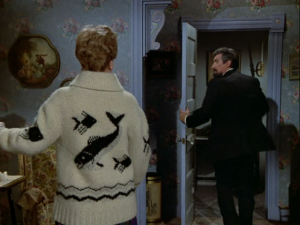
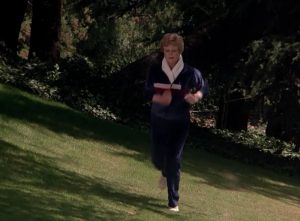 No matter where she goes, Jessica makes friends, from multi-millionaires to homeless wanderers. She respects other people’s stories and journeys without regard to the material benefits they can provide her, but, more importantly, without compromising her own needs or beliefs. When visiting the estate of a ridiculously wealthy friend, Jessica is to be seen jogging around his estate of a morning in her quintessential tracksuit, hair and make-up stunning and intact (see the photo on the left). While helping some local immigrants to Cabot Cove, Jessica not only faces down the US government, but a Soviet spy, as well. And then serves dinner without missing a beat.
No matter where she goes, Jessica makes friends, from multi-millionaires to homeless wanderers. She respects other people’s stories and journeys without regard to the material benefits they can provide her, but, more importantly, without compromising her own needs or beliefs. When visiting the estate of a ridiculously wealthy friend, Jessica is to be seen jogging around his estate of a morning in her quintessential tracksuit, hair and make-up stunning and intact (see the photo on the left). While helping some local immigrants to Cabot Cove, Jessica not only faces down the US government, but a Soviet spy, as well. And then serves dinner without missing a beat.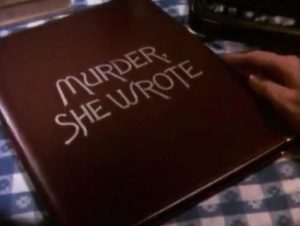 More than anything, as these examples show, Jessica is strong enough to live her life on her terms. She doesn’t shrink from living alone after the death of her husband, from starting a new career later in life, from venturing into a new romance (though no man ever got the best of Ms. J.B. Fletcher), from escaping from an ancient Irish castle, or from adopting one of her many impromptu disguises and swanning around where she is not otherwise allowed. And, no matter how many demands her friends, family, and her crime-fighting may make on her time, Jessica doesn’t let anything stand in the way of her writing. For twelve years (at least), she put out an average of two-and-a-half books a year.
More than anything, as these examples show, Jessica is strong enough to live her life on her terms. She doesn’t shrink from living alone after the death of her husband, from starting a new career later in life, from venturing into a new romance (though no man ever got the best of Ms. J.B. Fletcher), from escaping from an ancient Irish castle, or from adopting one of her many impromptu disguises and swanning around where she is not otherwise allowed. And, no matter how many demands her friends, family, and her crime-fighting may make on her time, Jessica doesn’t let anything stand in the way of her writing. For twelve years (at least), she put out an average of two-and-a-half books a year.